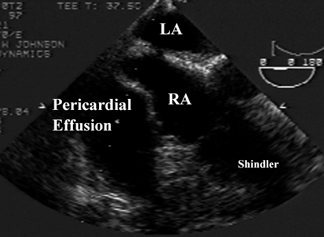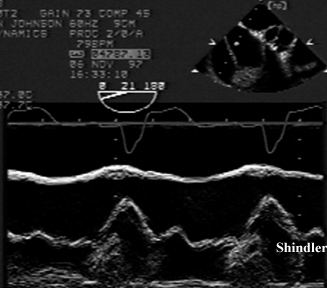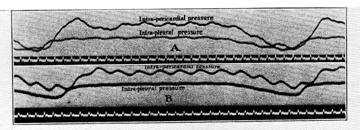

Transesophageal echo illustrating partial right atrial free wall collapse in a patient with cardiac tamponade. M-mode of the wall motion illustrates that the inversion is most prominent in late diastole.

The relationship of right atrial inversion, to the presence of cardiac tamponade was examined. The authors studied 127 patients with moderate or large pericardial effusions. Cardiac tamponade was present in 19 and absent in 104. Four patients with equivocal tamponade were excluded from analysis. Right atrial inversion was present in 19 of 19 patients with cardiac tamponade and 19 of 104 without cardiac tamponade (sensitivity, 100%; specificity, 82%; predictive value, 50%). The degree of inversion as quantitated by the area-corrected curvature did not improve the ability to discriminate between patients with and without cardiac tamponade. However, consideration of the duration of inversion by the right atrial inversion time index (duration of inversion/cardiac cycle length) and an empirically derived cut-off of 0.34 did improve the specificity and predictive value (100% and 100%, respectively) without a significant loss of sensitivity (94%). The authors conclude that right atrial inversion, particularly if prolonged, is a useful echocardiographic marker of cardiac tamponade that may be of particular diagnostic value when the clinical picture is unclear.
An inspiratory decline in systolic arterial blood pressure exceeding 10 mm Hg has been used clinically to identify hemodynamically significant pericardial effusions. Recently, the echocardiographic sign of right ventricular diastolic collapse (RVDC) has been shown to occur early in the course of cardiac tamponade in association with a hemodynamically important decline in cardiac output. This study was undertaken to compare the relative merits of pulsus paradoxus and the onset of RVDC in the early detection of cardiac tamponade in an unanesthetized canine preparation. We studied six chronically instrumented, conscious dogs with two-dimensional echocardiography during cardiac tamponade induced by continuous infusion of saline into the pericardial space. We recorded intrapericardial pressure, cardiac output (electromagnetic flowmeter), aortic (catheter-tip transducer) and right atrial blood pressures, heart rate, and respiration. None of the dogs had RVDC when the pericardial space was empty, but all dogs showed RVDC during cardiac tamponade. We found that RVDC was strongly related to all of the cardiac parameters evaluated (intrapericardial pressure, cardiac output, aortic blood pressure, heart rate, and stroke volume) and provided information on each that was independent of that provided by pulsus paradoxus. Furthermore, RVDC appeared to be more strongly related to most cardiac parameters than was pulsus paradoxus and to be more sensitive and specific than pulsus paradoxus in detecting changes in intrapericardial pressure early in cardiac tamponade.
Usefulness of right ventricular diastolic collapse in diagnosing
cardiac tamponade and comparison to pulsus paradoxus.
Singh S; Wann LS; Klopfenstein HS; Hartz A; Brooks HL
Am J Cardiol 1986 Mar 1;57(8):652-6
To compare the sensitivity, specificity and predictive value of right ventricular (RV) diastolic collapse and pulsus paradoxus as signs of cardiac tamponade, 21 consecutive patients with pericardial effusion and suspected cardiac tamponade underwent prospective hemodynamic and echocardiographic evaluation. Simultaneous hemodynamic and echocardiographic data were obtained in all patients before and after pericardiocentesis. Cardiac tamponade was considered present when there was diastolic equilibration of the intrapericardial, right atrial and pulmonary capillary wedge pressures and elevation of these pressures to more than 10 mm Hg. RV diastolic collapse was 93% sensitive and 100% specific in diagnosing cardiac tamponade, whereas pulsus paradoxus was only 79% sensitive and 40% specific. The positive and negative predictive values of RV diastolic collapse (100% and 83%) were considerably better than pulsus paradoxus (81% and 40%) and demonstrate that RV diastolic collapse is more sensitive, specific and predictive of cardiac tamponade than is pulsus paradoxus. Serial simultaneous hemodynamic and echocardiographic observations at multiple points during pericardiocentesis in a smaller subgroup (5 patients) also suggest that the hemodynamic effects of RV diastolic collapse in cardiac tamponade are mediated by an increase in intrapericardial pressure.
The most troublesome complication of acute pericarditis is recurrent episodes of pericardial inflammation, occurring in 15% to 32% of cases.
The cause of the recurrence is usually unknown, although in some cases it may be traced to viral infection or may be a consequence of coronary artery bypass grafting. The optimal method for prevention has not been fully established; accepted modalities include nonsteroidal anti-inflammatory drugs, corticosteroids, immunosuppressive agents, and pericardiectomy.
Based on the proven efficacy of colchicine therapy for familial Mediterranean fever (recurrent polyserositis), several small studies have used colchicine successfully to prevent recurrence of acute pericarditis after failure of conventional treatment.
In the largest multicenter international study - 51 patients were treated with colchicine to prevent further relapses and were followed up for up to 10 years.
The evidence for the efficacy and safety of colchicine for the prevention of recurrent episodes of pericarditis shows that colchicine may be an extremely promising adjunct to conventional treatment and may ultimately serve as the initial mode of treatment, especially in idiopathic cases.
Circulation 1998 Jun 2;97(21):2183-5
 Intrapericardial and intrapleural pressures showing comparable
respiratory variation in tracing A.
Intrapericardial and intrapleural pressures showing comparable
respiratory variation in tracing A.
Tracing B shows what happens when 70 ml of saline is instilled
into the pericardial space. The amount of respiratory variation
in the pericardial space pressure is decreased.
Katz LN, Gauchat HW. Observations on pulsus paradoxus (with
special reference to pericardial effusions).
Arch Intern Med 1924; 33:371-393
Surgical pathology of the parietal pericardium: a study of 344 cases (1993-1999).
Oh KY, Shimizu M, Edwards WD, Tazelaar HD, Danielson GK.
Cardiovasc Pathol 2001 Jul-Aug;10(4):157-68
Among 344 cases with surgically resected parietal pericardium, ages ranged from 1 to 87 years (mean, 55), and 64% were male. Causes of pericardial disease included neoplastic (33%), idiopathic (30%), iatrogenic (23%), and others (14%). Pericardial constriction (Group 1) represented the largest group (143 cases, 76% male). Maximal pericardial thickness was 1-17 mm (mean, 4). Fibrotic thickening occurred in 96%. Chronic lymphoplasmacytic inflammation affected 73% (mild or moderate in 97%). Calcification was uncommon (gross in 28%, microscopic in 8%), and granulomas were rare (4%, none tubercular). Constriction was idiopathic in 49% and iatrogenic (postpericardiotomy or postirradiation) in 41%. Neoplasms and cysts (Group 2) represented the second largest group (96 cases). Among 43 cases with secondary pericardial involvement, carcinomas accounted for 53% and lymphomas 21%. Forty cases (Group 3) had pericardial effusions (75% chronic), which were idiopathic in 28% and postpericardiotomy in 23%. Thirty-three cases (Group 4) had acute or recurrent pericarditis clinically, which was idiopathic in 70%. Lastly, 32 cases (Group 5) had pericardial resection for conditions unrelated to primary pericardial disease. In conclusion, pericardial constriction tended to be nontubercular (100%), nongranulomatous (96%), idiopathic or iatrogenic (90%), and noncalcific (64%), and it could occur with normal pericardial thickness (4%). Because considerable overlap in the gross and microscopic features existed among cases with noncalcific pericardial constriction (Group 1), pericardial effusions (Group 3), and pericarditis (Group 4), clinical information was necessary to provide an accurate clinicopathologic interpretation.
Pulsus paradoxus was described by Kussmaul in 1873, but there is still no agreement on the underlying mechanism. A combination of factors may contribute to pulsus paradoxus depending upon the peripheral blood volume, the magnitude of swings in pleural pressure, the state of cardiac contractility, and the degree of lung hyperinflation (in non-tamponade patients with lung disease).
The following mechanisms have been proposed:
Back to E-chocardiography Home Page.
e-mail:shindler@umdnj.edu
The contents and links on this page were last verified on January 23, 2004.